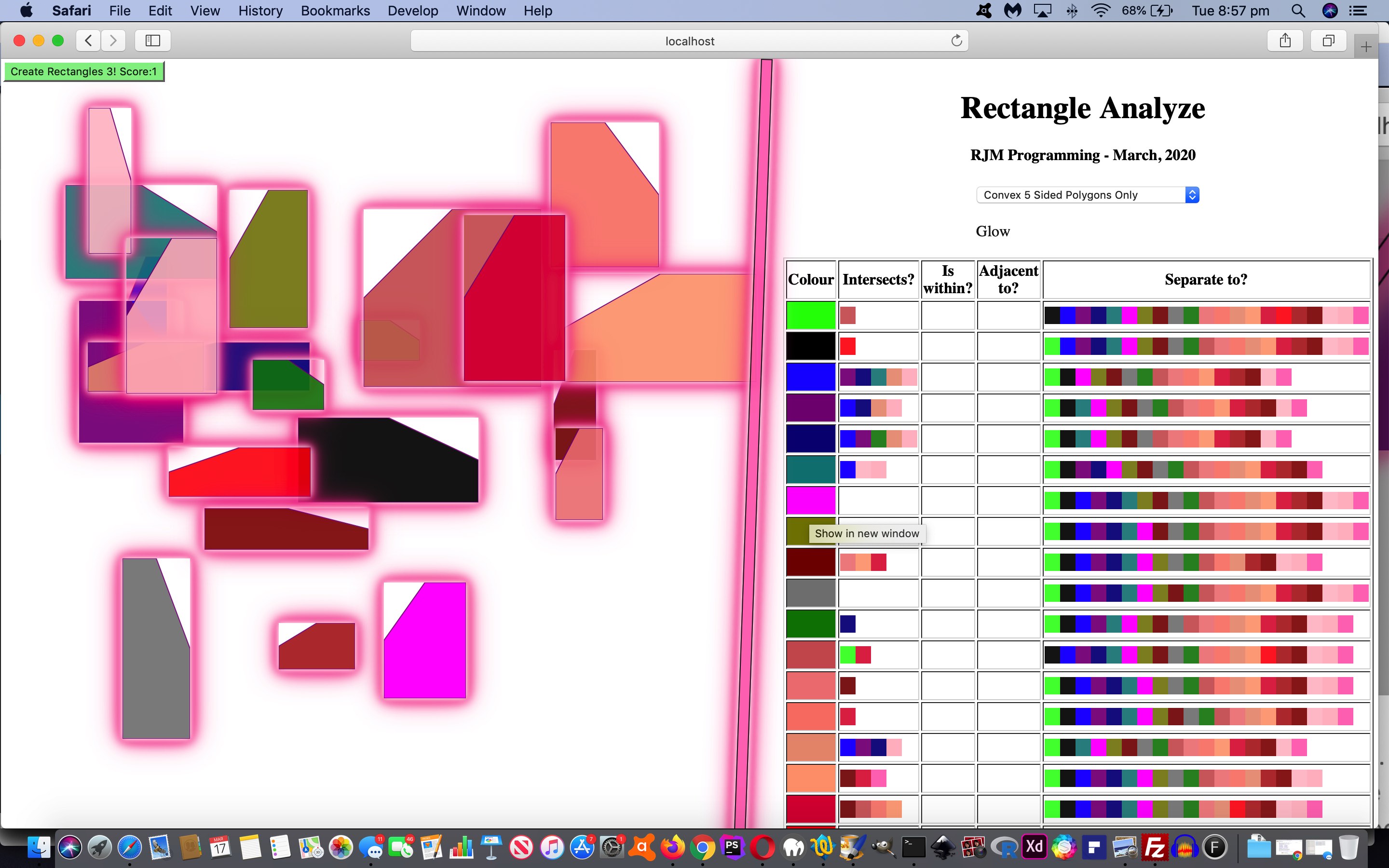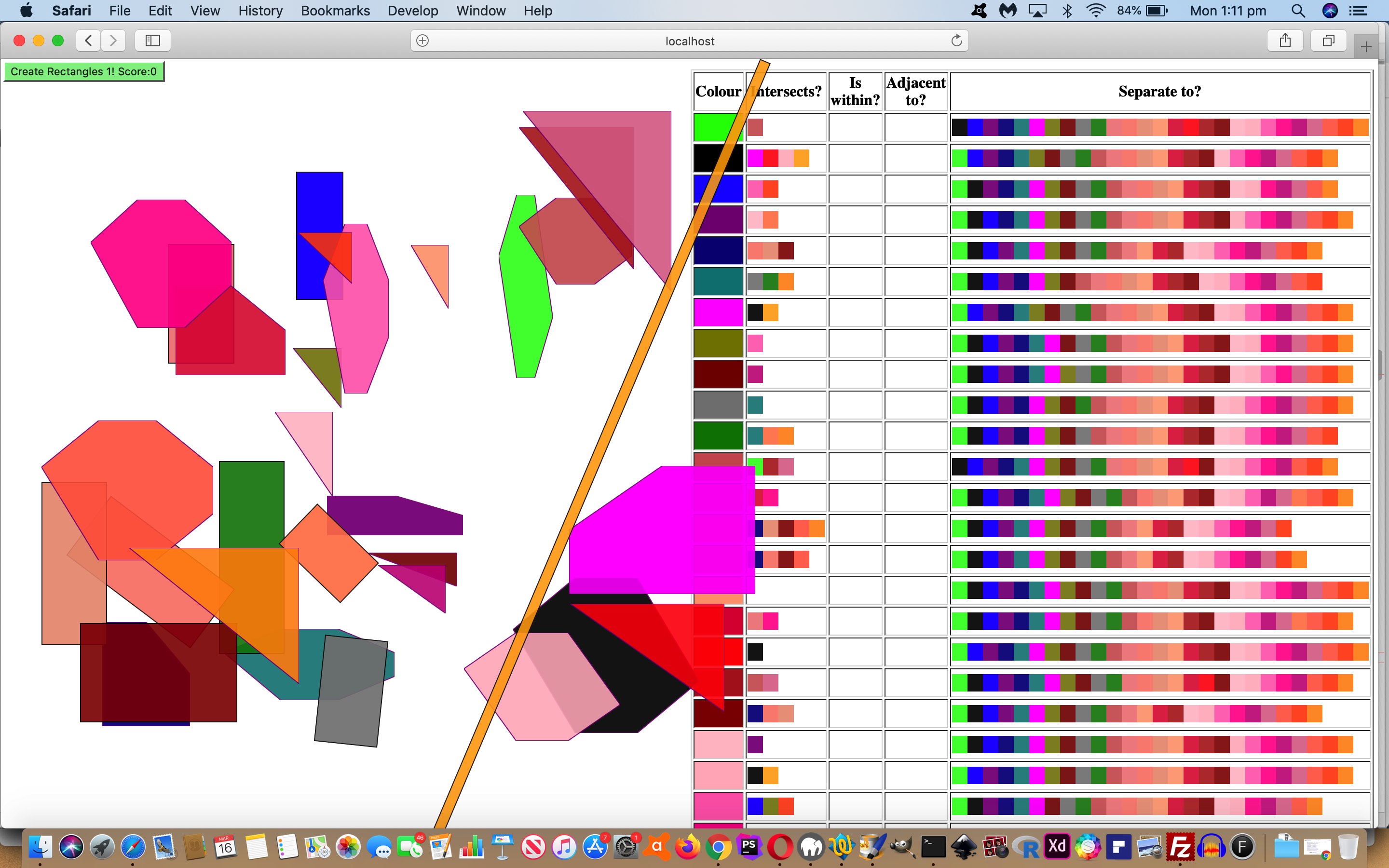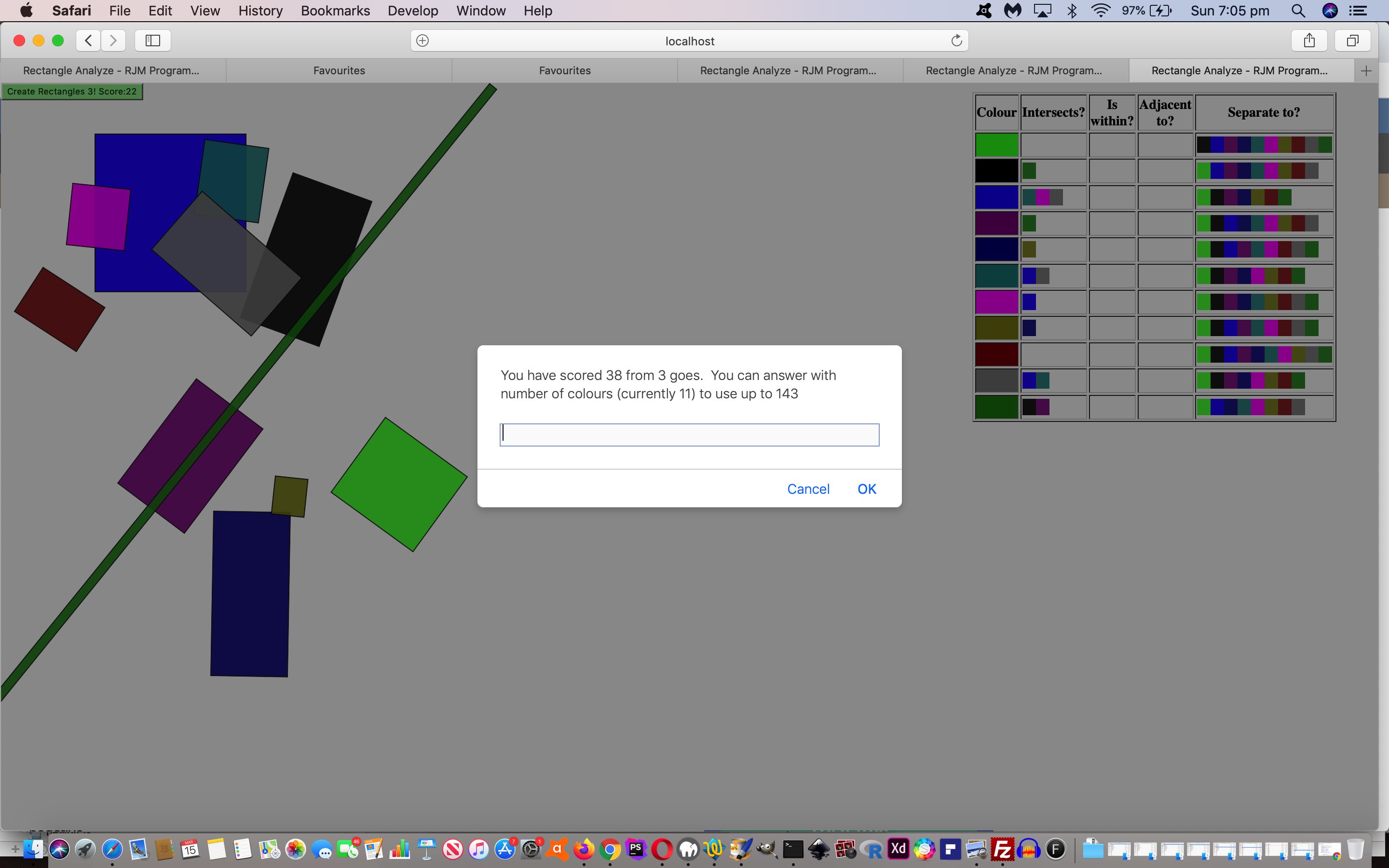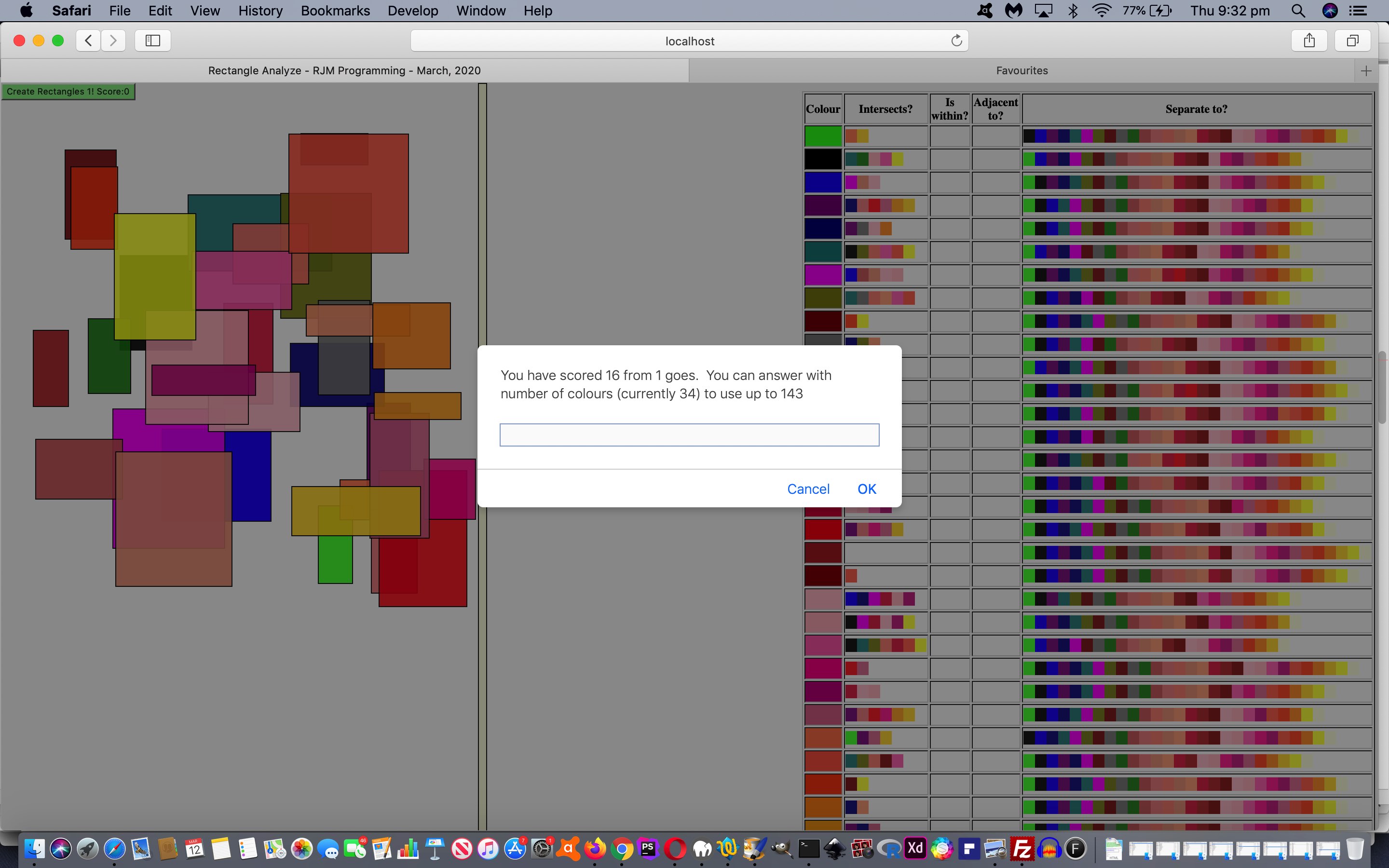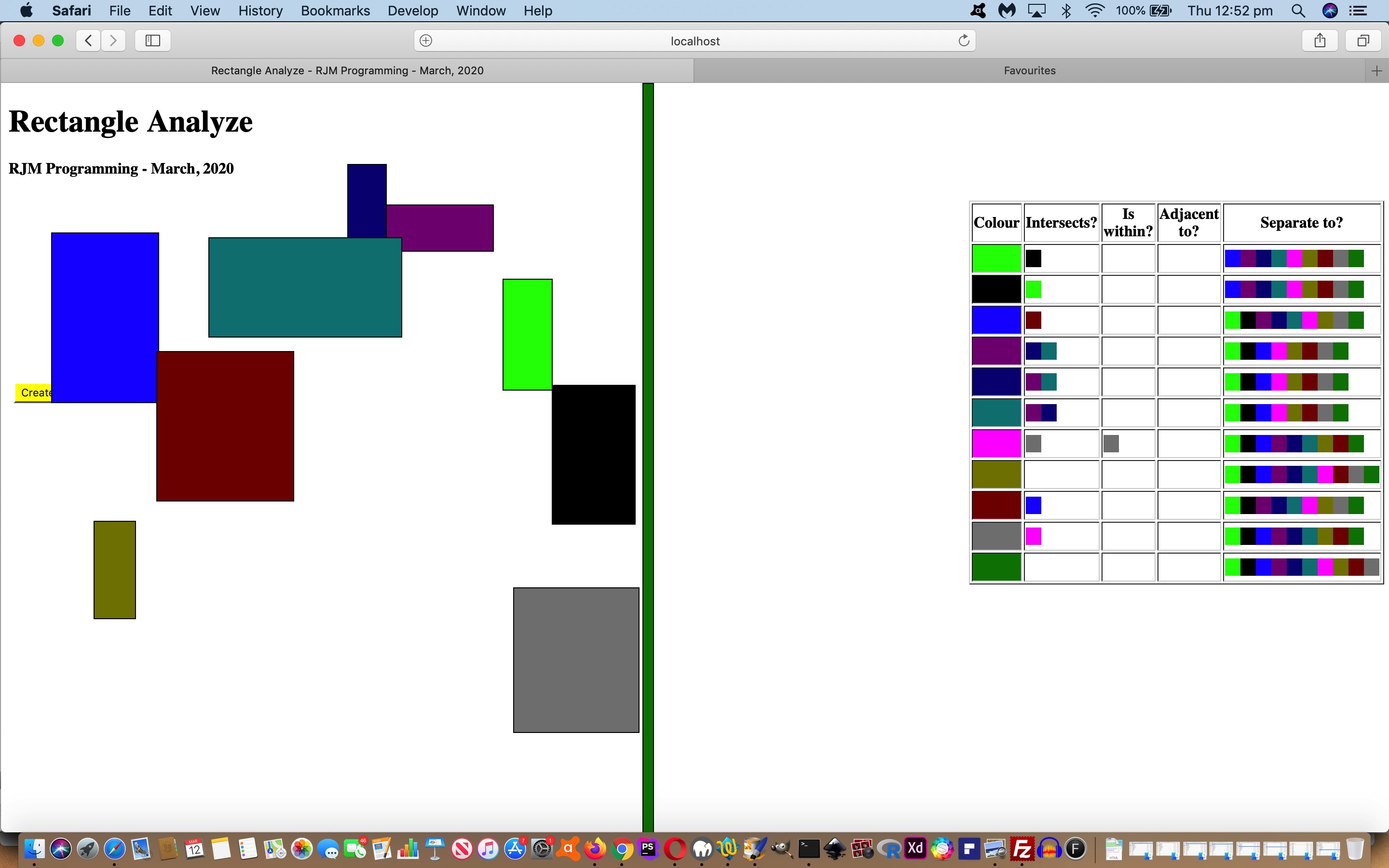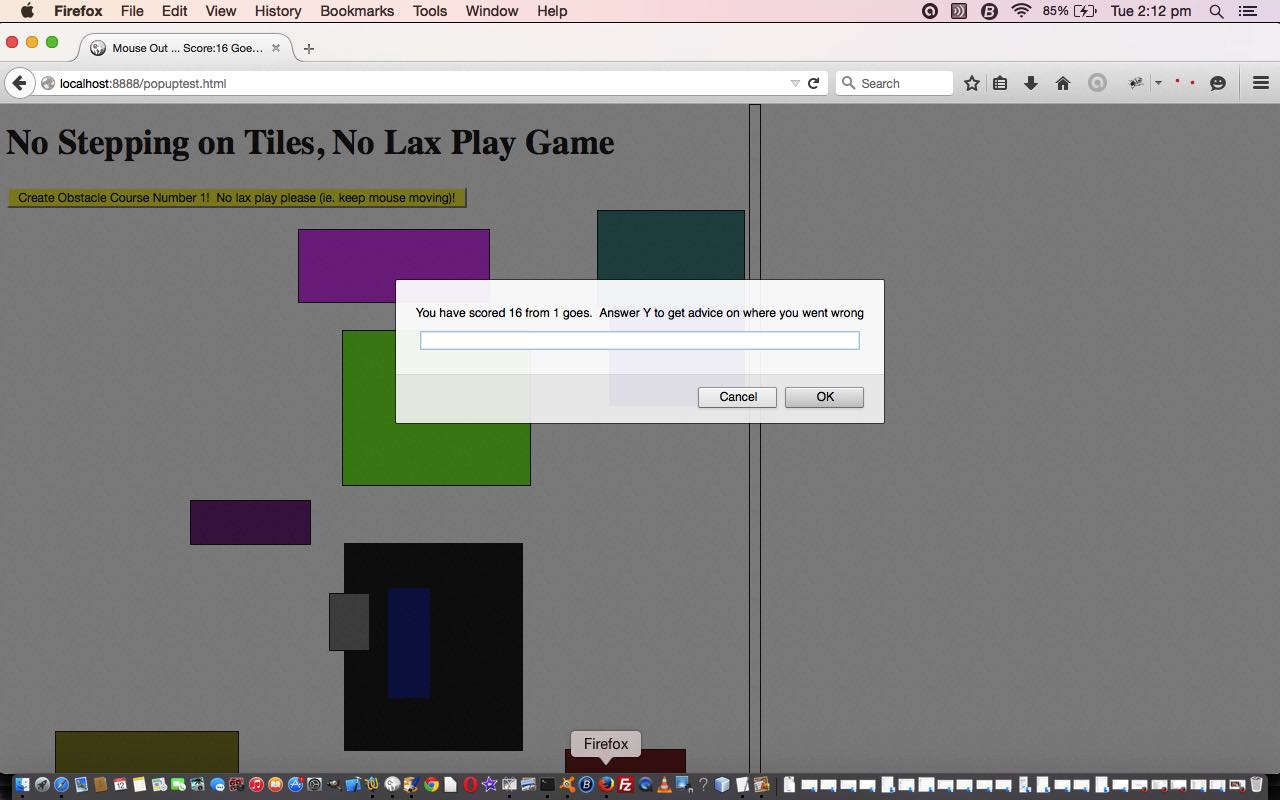The recent Javascript Convex Polygon Analyze Tutorial lacked some straightforward means by which the user could control (via ? and & address bar URL argument manipulations) …
- newly instigated “glow” CSS as per …
var dglowc='';
if (document.URL.indexOf('glow=') != -1) { dglowc=' checked'; }
var prehtmltablerteport=('<h1 style="text-align:center;width:100%;">Rectangle Analyze <input onblur="relevant=false; setTimeout(obchange,3000);" onchange="relevant=false; setTimeout(obchange,3000);" onclick="relevant=false;" type=number id=selensidenum min=2 max=' + allcols.length + ' value=' + ('~' + orignumcols + '~').replace('~~','11').replace('~','').replace('~','') + '></input></h1><h4 style="text-align:center;width:100%;">RJM Programming - March, 2020</h4><select id=raselect onclick="relevant=false; event.stopPropagation();" onchange="relevant=false; sidelimit(this.value);" style="margin-left:150px;"><option value="">Convex 3/4/5/6/7/8 Sided Polygon Mix</option><option value="3">Convex 3 Sided Polygons Only</option><option value="4">Convex 4 Sided Polygons Only</option><option value="5">Convex 5 Sided Polygons Only</option><option value="6">Convex 6 Sided Polygons Only</option><option value="7">Convex 7 Sided Polygons Only</option><option value="8">Convex 8 Sided Polygons Only</option></select><br><br><span style="margin-left:150px;">Glow <input type="checkbox" onclick="relevant=false;" onchange="relevant=false; glowit(this);" id="cbglow"' + dglowc + '></input></span><br><br><table onclick="relevant=false; woit(this);" title="Show in new window" id=mytable border=1 id=trep style=width:30%;align:right;z-index:67;margin-right:10px;><tr><th>Colour</th><th>Intersects?</th><th>Is within?</th><th>Adjacent to?</th><th>Separate to?<input id=iootw type=text style=position:absolute;top:-200px;left:-200px; value=""></input></th></tr></table><span id=thright></span>').replace(' value="' + orignumsides + '"', ' value="' + orignumsides + '" selected');
function glowit(cbo) {
if (cbo.checked) {
document.getElementById('thright').innerHTML+="<style> div { -webkit-animation: glow 1s ease-in-out infinite alternate; -moz-animation: glow 1s ease-in-out infinite alternate; animation: glow 1s ease-in-out infinite alternate; } @-webkit-keyframes glow { from { box-shadow: 0 0 3px #fff, 0 0 5px #fff, 0 0 37px #e60073, 0 0 9px #e60073, 0 0 11px #e60073, 0 0 13px #e60073, 0 0 15px #e60073; } to { box-shadow: 0 0 24px #fff, 0 0 6px #ff4da6, 0 0 8px #ff4da6, 0 0 10px #ff4da6, 0 0 12px #ff4da6, 0 0 14px #ff4da6, 0 0 16px #ff4da6; } } </style> ";
htmltablerteport=htmltablerteport.replace('></span>','>' + document.getElementById('thright').innerHTML + '</span>').replace(' id="cbglow"',' id="cbglow" style=display:none;');
prehtmltablerteport=prehtmltablerteport.replace('></span>','>' + document.getElementById('thright').innerHTML + '</span>').replace(' id="cbglow"',' id="cbglow" style=display:none;');
dglow='&glow=y';
} else {
document.getElementById('thright').innerHTML=document.getElementById('thright').innerHTML.split('<style')[0];
dglow='';
}
cbo.style.visibility='hidden';
}
function cit() {
if ( document.getElementById('cbglow').checked) {
document.getElementById('thright').innerHTML+="<style> div { -webkit-animation: glow 1s ease-in-out infinite alternate; -moz-animation: glow 1s ease-in-out infinite alternate; animation: glow 1s ease-in-out infinite alternate; } @-webkit-keyframes glow { from { box-shadow: 0 0 3px #fff, 0 0 5px #fff, 0 0 37px #e60073, 0 0 9px #e60073, 0 0 11px #e60073, 0 0 13px #e60073, 0 0 15px #e60073; } to { box-shadow: 0 0 24px #fff, 0 0 6px #ff4da6, 0 0 8px #ff4da6, 0 0 10px #ff4da6, 0 0 12px #ff4da6, 0 0 14px #ff4da6, 0 0 16px #ff4da6; } } </style> ";
htmltablerteport=htmltablerteport.replace('></span>','>' + document.getElementById('thright').innerHTML + '</span>').replace(' id="cbglow"',' id="cbglow" style=display:none;');
prehtmltablerteport=prehtmltablerteport.replace('></span>','>' + document.getElementById('thright').innerHTML + '</span>').replace(' id="cbglow"',' id="cbglow" style=display:none;');
dglow='&glow=y';
}
}
if (document.URL.indexOf('glow=') != -1) { setTimeout(cit, 1200); }
- newly instigated enforced number of polygon sides from 3 to 8 as per …
var orignumsides=location.search.split('numsides=')[1] ? decodeURIComponent(location.search.split('numsides=')[1].split('&')[0]) : '';
var prehtmltablerteport=('<h1 style="text-align:center;width:100%;">Rectangle Analyze <input onblur="relevant=false; setTimeout(obchange,3000);" onchange="relevant=false; setTimeout(obchange,3000);" onclick="relevant=false;" type=number id=selensidenum min=2 max=' + allcols.length + ' value=' + ('~' + orignumcols + '~').replace('~~','11').replace('~','').replace('~','') + '></input></h1><h4 style="text-align:center;width:100%;">RJM Programming - March, 2020</h4><select id=raselect onclick="relevant=false; event.stopPropagation();" onchange="relevant=false; sidelimit(this.value);" style="margin-left:150px;"><option value="">Convex 3/4/5/6/7/8 Sided Polygon Mix</option><option value="3">Convex 3 Sided Polygons Only</option><option value="4">Convex 4 Sided Polygons Only</option><option value="5">Convex 5 Sided Polygons Only</option><option value="6">Convex 6 Sided Polygons Only</option><option value="7">Convex 7 Sided Polygons Only</option><option value="8">Convex 8 Sided Polygons Only</option></select><br><br><span style="margin-left:150px;">Glow <input type="checkbox" onclick="relevant=false;" onchange="relevant=false; glowit(this);" id="cbglow"' + dglowc + '></input></span><br><br><table onclick="relevant=false; woit(this);" title="Show in new window" id=mytable border=1 id=trep style=width:30%;align:right;z-index:67;margin-right:10px;><tr><th>Colour</th><th>Intersects?</th><th>Is within?</th><th>Adjacent to?</th><th>Separate to?<input id=iootw type=text style=position:absolute;top:-200px;left:-200px; value=""></input></th></tr></table><span id=thright></span>').replace(' value="' + orignumsides + '"', ' value="' + orignumsides + '" selected');
function sidelimit(tvis) {
if (tvis == '') {
location.href=(document.URL.split('#')[0].replace('numsides=','nXumsides=').replace('glow=','gXlow=') + dglow).replace('.htm&','.htm?').replace('.html&','.html?');
} else {
location.href=(document.URL.split('#')[0].replace('numsides=','nXumsides=').replace('glow=','gXlow=') + '&numsides=' + tvis + dglow).replace('.htm&','.htm?').replace('.html&','.html?');
}
}
- improved number of polygon sides as per …
var orignumcols=location.search.split('numcols=')[1] ? decodeURIComponent(location.search.split('numcols=')[1].split('&')[0]) : '';
var prehtmltablerteport=('<h1 style="text-align:center;width:100%;">Rectangle Analyze <input onblur="relevant=false; setTimeout(obchange,3000);" onchange="relevant=false; setTimeout(obchange,3000);" onclick="relevant=false;" type=number id=selensidenum min=2 max=' + allcols.length + ' value=' + ('~' + orignumcols + '~').replace('~~','11').replace('~','').replace('~','') + '></input></h1><h4 style="text-align:center;width:100%;">RJM Programming - March, 2020</h4><select id=raselect onclick="relevant=false; event.stopPropagation();" onchange="relevant=false; sidelimit(this.value);" style="margin-left:150px;"><option value="">Convex 3/4/5/6/7/8 Sided Polygon Mix</option><option value="3">Convex 3 Sided Polygons Only</option><option value="4">Convex 4 Sided Polygons Only</option><option value="5">Convex 5 Sided Polygons Only</option><option value="6">Convex 6 Sided Polygons Only</option><option value="7">Convex 7 Sided Polygons Only</option><option value="8">Convex 8 Sided Polygons Only</option></select><br><br><span style="margin-left:150px;">Glow <input type="checkbox" onclick="relevant=false;" onchange="relevant=false; glowit(this);" id="cbglow"' + dglowc + '></input></span><br><br><table onclick="relevant=false; woit(this);" title="Show in new window" id=mytable border=1 id=trep style=width:30%;align:right;z-index:67;margin-right:10px;><tr><th>Colour</th><th>Intersects?</th><th>Is within?</th><th>Adjacent to?</th><th>Separate to?<input id=iootw type=text style=position:absolute;top:-200px;left:-200px; value=""></input></th></tr></table><span id=thright></span>').replace(' value="' + orignumsides + '"', ' value="' + orignumsides + '" selected');
function obchange() {
var synopsis=document.getElementById('selensidenum').value;
location.href=(document.URL.split('#')[0].replace('numcols=','nXumcols=').replace('glow=','gXlow=') + '&numcols=' + synopsis + dglow).replace('.htm&','.htm?').replace('.html&','.html?');
}
… considerations that needed the setInterval(onesec,1000) to be made setInterval(onesec,9000) (ie. 5 seconds) to allow more time for user interaction possibilities.
Yet again, you can try this with the changed rectangle_analyze.htm live run link is there for your perusal.
Previous relevant Javascript Convex Polygon Analyze Tutorial is shown below.
We progress on our latest web application from the progress up to Javascript Rotated Rectangle Analyze Tutorial by allowing for …
- unrotated triangle
- unrotated convex 5 sided polygon
- unrotated convex 6 sided polygon
- unrotated convex 7 sided polygon
- unrotated convex 8 sided polygon … onto the previously (attended to) …
- unrotated rectangle
- rotated rectangle
… and we turn to those HTML div element “innards”. Up to yesterday those “innard” innerHTML were unimportant, but today, with those extensions to functionality we need SVG “innards” like …
<svg height="100%" width="100%"><polygon points="51,0 102,0 153,54.333333333333336 153,108.66666666666667 102,163 51,163 0,108.66666666666667 0,54.333333333333336" style="fill:blue;stroke:purple;stroke-width:1"></polygon></svg>
… and to further differentiate these non-four sided polygons from the four sided rectangle (polygons) of recent times, we add to that relevant HTML div “encasing” element’s title attribute the non-translated co-ordinate set of that SVG points attribute above (representing the “absolute” positioning data we need for our trigonometrical and geometrical calculations to match with HTML div (encasing or not) style=position:absolute;left:[topLeftX]px;top:[topLeftY]px; (familiar to “overlay” reader enthusiasts)), the heads up needed for knowing to do this coming from the predecessor SVG Absolute Positioning Sharing Tutorial.
And so, again, you can try this with the changed rectangle_analyze.htm live run link is there for your perusal.
Previous relevant Javascript Rotated Rectangle Analyze Tutorial is shown below.
The Javascript logic of the recent Javascript Rectangle Analyze Follow Up Tutorial needed no trigonometrical mathematics, but the simple progression from …
- HTML div rectangle data … to …
- randomly rotated HTML div rectangle data … via CSS style=”transform:rotate(30deg);transform-origin:left top;” type syntax … (we are going to start referring to as “polygon” below … though a very small subset … we need to continue past today’s work)
… input complicates the Javascript logic hugely, as well as needing trigonometrical mathematics via Javascript Math.sin and Math.cos and the great help we got from various online sources we used with the blog posting thread headed by Viewport and CSS Calc Intersection Resize Tutorial to …
- determine if a point lies within a polygon … on the way to …
- determine if two polygons intersect (and so, also, if one polygon lies totally within another, and if the area of an intersecting polygon is zero that those two polygons are adjacent)
Again, you can try this with the changed rectangle_analyze.htm live run link is there for your perusal.
Perhaps you have deduced why this trivial changed step to the web application sophistication was important, but not the be all and end all for proceeding past four sided polygons?! We’ll be explaining more at a later date.
Previous relevant Javascript Rectangle Analyze Follow Up Tutorial is shown below.
As improvements to yesterday’s Javascript Rectangle Analyze Primer Tutorial we thought …
- allow the user to change the number of colours from its default 11 … and we thank Color Names — HTML Color Codes to allow us to get to around 140 HTML colour names …
// Thanks to https://htmlcolorcodes.com/color-names/ below
var allcols=['lime','black','blue','purple','navy','teal','fuchsia','olive','maroon','gray','green',
'IndianRed','LightCoral','Salmon','DarkSalmon','LightSalmon','Crimson','Red','FireBrick','DarkRed',
'Pink','LightPink','HotPink','DeepPink','MediumVioletRed','PaleVioletRed','Coral',
'Tomato','OrangeRed','DarkOrange','Orange','Gold','Yellow','LightYellow',
'LemonChiffon','LightGoldenrodYellow','PapayaWhip','Moccasin','PeachPuff',
'PaleGoldenrod','Khaki','DarkKhaki','Lavender','Thistle',
'Plum','Violet','Orchid','Fuchsia','Magenta',
'MediumOrchid','MediumPurple','RebeccaPurple',
'BlueViolet','DarkViolet','DarkOrchid','DarkMagenta',
'Indigo','SlateBlue','DarkSlateBlue','MediumSlateBlue',
'GreenYellow','Chartreuse','LawnGreen','LimeGreen',
'PaleGreen','LightGreen','MediumSpringGreen','SpringGreen',
'MediumSeaGreen','SeaGreen','ForestGreen','DarkGreen',
'YellowGreen','OliveDrab','DarkOliveGreen','MediumAquamarine','DarkSeaGreen',
'LightSeaGreen','DarkCyan','Aqua','Cyan','LightCyan','PaleTurquoise',
'Aquamarine','Turquoise','MediumTurquoise','DarkTurquoise',
'CadetBlue','SteelBlue','LightSteelBlue','PowderBlue',
'LightBlue','SkyBlue','LightSkyBlue','DeepSkyBlue','DodgerBlue','CornflowerBlue',
'MediumSlateBlue','RoyalBlue','MediumBlue','DarkBlue','Navy',
'MidnightBlue','Cornsilk','BlanchedAlmond','Bisque','NavajoWhite','Wheat',
'BurlyWood','Tan','RosyBrown','SandyBrown','Goldenrod',
'DarkGoldenrod','Peru','Chocolate','SaddleBrown','Sienna','Brown','Snow',
'HoneyDew','MintCream','Azure','AliceBlue','GhostWhite','WhiteSmoke','SeaShell',
'Beige','OldLace','FloralWhite','Ivory','AntiqueWhite','Linen',
'LavenderBlush','MistyRose','Gainsboro','LightGray','Silver','DarkGray','DimGray',
'LightSlateGray','SlateGray','DarkSlateGray'];
… for use here … checking for prompt window driven user (?numcols=) argument control response …
var bks=' ';
var argnumcols=location.search.split('numcols=')[1] ? decodeURIComponent(location.search.split('numcols=')[1].split('&')[0]) : '11';
var cols=['lime','black','blue','purple','navy','teal','fuchsia','olive','maroon','gray','green'];
var xs=[0,0,0,0,0,0,0,0,0,0,0];
var ys=[0,0,0,0,0,0,0,0,0,0,0];
var ls=[0,0,0,0,0,0,0,0,0,0,0];
var ts=[0,0,0,0,0,0,0,0,0,0,0];
var ws=[0,0,0,0,0,0,0,0,0,0,0];
var hs=[0,0,0,0,0,0,0,0,0,0,0];
var pw=[null,null,null,null,null,null,null,null,null,null,null];
var ps=[null,null,null,null,null,null,null,null,null,null,null];
if (eval('' + argnumcols) != 11) {
if (eval('' + argnumcols) >= 40) { bks=' '; }
cols=[];
xs=[];
ys=[];
ls=[];
ts=[];
ws=[];
hs=[];
pw=[];
ps=[];
for (var ijk=0; ijk<argnumcols; ijk++) {
cols.push(allcols[ijk]);
xs.push(0);
ys.push(0);
ls.push(0);
ts.push(0);
ws.push(0);
hs.push(0);
pw.push(null);
ps.push(null);
}
}
- and if this results in a bit too crowded a scenario we now allow a click on the GIS Report Table to open that report in a new popup window as per the changed …
var prehtmltablerteport='<table onclick="woit(this);" title="Show in new window" id=mytable border=1 id=trep style=width:30%;align:right;z-index:67;margin-right:10px;><tr><th>Colour</th><th>Intersects?</th><th>Is within?</th><th>Adjacent to?</th><th>Separate to?<input id=iootw type=text style=position:absolute;top:-200px;left:-200px; value=""></input></th></tr></table>';
… calling on the new Javascript function …
var wo=null;
function woit(tois) {
if (wo != null) {
wo.close();
wo=null;
}
wo=window.open('','_blank','top=20,left=20,width=900,height=900');
wo.document.write('<html><body>' + tois.outerHTML + '</body></html>');
}
You can try this with the changed rectangle_analyze.htm live run link is there for your perusal should this be of interest.
Previous relevant Javascript Rectangle Analyze Primer Tutorial is shown below.
We’re not trying to compare programming to Michelangelo’s art, but did you know that he chose the marble he wanted at the quarry, presumably imagining what was possible with that marble?
In line with that, do you like “glass half full” thinking rather than “glass half empty” thinking? We prefer the “glass half full” choice, and use that thinking (and a “laziness” “background noise”) to see what has come before to shape the workings of a new programming project.
This new project touches on GIS (Geographic Information System) ideas, but is a simplified form, so far, regarding unrotated rectangle HTML (div) data set (of 11) to check (amongst them) for …
- does rectangle A intersect with rectangle B?
- is rectangle A within rectangle B?
- is rectangle A adjacent to rectangle B?
- is rectangle A separate to rectangle B?
How to approach our programming aim above? Well, we thought we’d base it on that of HTML/Javascript PopUp Mouseover Event Game Tutorial. Huh?! Yes, “laziness” thoughts will have a programmer’s mind fishing for another project that randomly creates those (HTML div) elements, and this was the attraction. Then you need to start “Michelangelo”ing the new web application from the old, and we decided if we could not creep up on a web application that can create a “tabular report (of any sort) to the right” within an hour’s work, then we would classify that as a bad “glass half full” approach. Thankfully, though, it panned out to be a good approach, so read on.
And then there is all that knowledge on the “net” helping formulate three Javascript functions to help with the GIS logic thoughts above as per …
function intersectRect(r1, r2) { // thanks to https://stackoverflow.com/questions/2752349/fast-rectangle-to-rectangle-intersection
return !(r2.left > r1.right ||
r2.right < r1.left ||
r2.top > r1.bottom ||
r2.bottom < r1.top);
}
function adjacentTo(r1, r2) { // thanks to https://stackoverflow.com/questions/2752349/fast-rectangle-to-rectangle-intersection
if (intersectRect(r1, r2)) {
return (r2.left == r1.right ||
r2.right == r1.left ||
r2.top == r1.bottom ||
r2.bottom == r1.top);
} else {
return false;
}
}
function contains(r1, r2) { // thanks to https://stackoverflow.com/questions/27768039/find-out-if-a-rectangle-is-inside-another-rectangle-c
if ( (r2.right) < (r1.right)
&& (r2.left) > (r1.left)
&& (r2.top) > (r1.top)
&& (r2.bottom) < (r1.bottom) ) {
return true;
} else {
return false;
}
}
… “data organized” via …
var cmds=[];
var rects=[];
function MakePopup(event, popupWindow, popupIsShown, colis, lis, tis, wis, his, indx) {
if (1 == 56 && window.createPopup) { //Internet Explorer
if (!popupWindow) {
popupWindow = window.createPopup();
var popupBody = popupWindow.document.body;
popupBody.style.backgroundColor = colis; //"lightblue";
cmds.push("document.getElementById('col" + indx + "').style.backgroundColor='" + colis + "'");
if (indx == 0) { setTimeout(andlater,200); }
popupBody.style.border = "solid black 1px";
if (1 == 2) popupBody.innerHTML = "Click outside to close.";
}
popupWindow.show (lis, tis, wis, his, document.body); //100, 100, 150, 25, document.body);
pword="client";
}
else {
if (!popupIsShown) {
if (!popupWindow) {
popupWindow = document.createElement("div");
popupWindow.style.backgroundColor = colis; //"lightblue";
cmds.push("document.getElementById('col" + indx + "').style.backgroundColor='" + colis + "'");
if (indx == 0) { setTimeout(andlater,200); }
popupWindow.style.border = "solid black 1px";
popupWindow.style.position = "absolute";
popupWindow.style.width = wis + "px"; //150
popupWindow.style.height = his + "px"; //25
popupWindow.style.top = tis + "px"; //"100px";
popupWindow.style.left = lis + "px"; //"100px";
if (1 == 2) popupWindow.innerHTML = "Click outside to close.";
}
document.body.appendChild(popupWindow);
rects.push(popupWindow.getBoundingClientRect());
if (pword == "") window.addEventListener('mouseover', MouseOver, true);
popupIsShown = true;
// to avoid that the current click event propagates up
if (pword == "") event.stopPropagation ();
}
pword="page";
}
}
… and feeding into the GIS report HTML table updating Javascript …
function andlater() {
for (var ji=0; ji<cmds.length; ji++) {
eval(cmds[ji]);
}
for (var kji=0; kji<rects.length; kji++) {
var seprt=false;
document.getElementById('intersects' + kji).innerHTML='';
document.getElementById('within' + kji).innerHTML='';
document.getElementById('adjacent' + kji).innerHTML='';
document.getElementById('separate' + kji).innerHTML='';
for (var mji=0; mji<rects.length; mji++) {
if (mji != kji) {
seprt=true;
if (mji > kji || 1 == 1) {
if (intersectRect(rects[kji], rects[mji])) {
seprt=false;
if (document.getElementById('intersects' + kji).innerHTML.indexOf(cmds[mji].split("='")[1].split("'")[0]) == -1) {
document.getElementById('intersects' + kji).innerHTML+='<span style=background-color:' + cmds[mji].split("='")[1].split("'")[0] + ';> </span>';
}
}
if (adjacentTo(rects[kji], rects[mji])) {
seprt=false;
if (document.getElementById('adjacent' + kji).innerHTML.indexOf(cmds[mji].split("='")[1].split("'")[0]) == -1) {
document.getElementById('adjacent' + kji).innerHTML+='<span style=background-color:' + cmds[mji].split("='")[1].split("'")[0] + ';> </span>';
}
}
}
if (contains(rects[mji], rects[kji])) {
seprt=false;
if (document.getElementById('within' + kji).innerHTML.indexOf(cmds[mji].split("='")[1].split("'")[0]) == -1) {
document.getElementById('within' + kji).innerHTML+='<span style=background-color:' + cmds[mji].split("='")[1].split("'")[0] + ';> </span>';
}
}
if (seprt) {
document.getElementById('separate' + kji).innerHTML+='<span style=background-color:' + cmds[mji].split("='")[1].split("'")[0] + ';> </span>';
}
}
}
}
cmds=[];
rects=[];
}
The chiselled rectangle_analyze.html live run link is there for your perusal should this be of interest.
Previous relevant HTML/Javascript PopUp Mouseover Event Game Tutorial is shown below.
Are you …
- a fan of Mission Impossible
- amazed when Rafael Nadal avoids walking on the lines
- when accidentally dropping your toast, hoping it lands butter up
…? If you scored 2 or above … please read on. If you scored zero … well, I’m speechless!
Today we’ve written a mouse movement and popup window game for your perusal after the great advice we stumbled upon with this webpage about the createPopup Window (object) method … thanks.
The idea of this game (for laptops) is to …
- not step on any tiles of the obstacle course presented to you once you click the button
- keep your mouse moving in an interesting way
- move the mouse fast enough to avoid the program claim of passivity … like in Judo
The workings of the game in HTML and Javascript rely on …
- createPopup Window object method
- the (on)mouseover mouse event
- Javascript setInterval timer
- clearing and rewriting document.body.innerHTML (rather than reloading webpage with a URL of any sort)
So try the live run and/or examine, download, or use the HTML and Javascript (DOM) source code you could call popuptest.html
If this was interesting you may be interested in this too.
If this was interesting you may be interested in this too.
If this was interesting you may be interested in this too.
If this was interesting you may be interested in this too.
If this was interesting you may be interested in this too.
If this was interesting you may be interested in this too.

